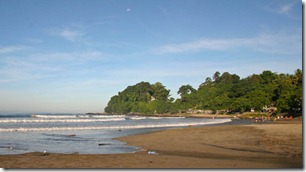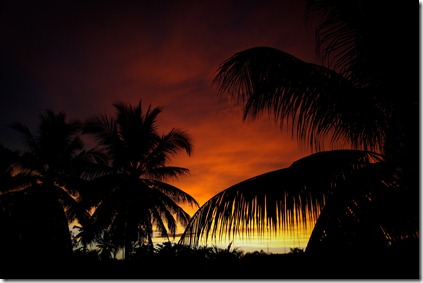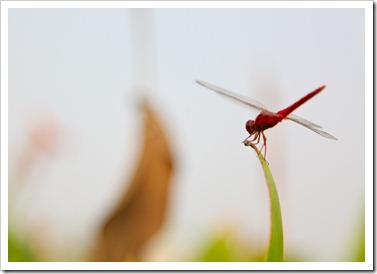The road drops steeply beneath you as you wind down the hill side. As you reach the valley floor bellow the landscape quickly changes from forest and bamboo huts to the first thing that looks like a regular city road since you left Bogor.  The road is lined with multi-story cinderblock shops; shabby looking, but active and filled with flimsy looking merchandise ranging from baby clothes to office supplies to satellite dishes. There is even a sidewalk with occasional food stalls taking up most of it. You’re in Pelabuhan Ratu. The shops stretch on a long way, broken only by the large expanse of a playing field and Islamic school building on your right. Suddenly the road is crowded with stopped bemo and the road veers to the right. The smell of fish and dust rise from the market entrance to your left where the fishermen peddle their morning catch. To your right, are the bright colors of the fruit and vegetable stands.
The road is lined with multi-story cinderblock shops; shabby looking, but active and filled with flimsy looking merchandise ranging from baby clothes to office supplies to satellite dishes. There is even a sidewalk with occasional food stalls taking up most of it. You’re in Pelabuhan Ratu. The shops stretch on a long way, broken only by the large expanse of a playing field and Islamic school building on your right. Suddenly the road is crowded with stopped bemo and the road veers to the right. The smell of fish and dust rise from the market entrance to your left where the fishermen peddle their morning catch. To your right, are the bright colors of the fruit and vegetable stands.
And then the city ends as quickly as it began and you’re view is now split between palm tree and the brownish sea lapping gently against the dirty sand of Samudra Beach. Thatched stalls hawking food, bottled drinks and fresh coconuts dot the shoulder. You’re in Citepus. You’re still too far east for the waves to be of any appreciable size, but as you reach the drab, hulking Inna Samudra with is utilitarian concrete facade, they’ve grown considerably and the hollow greenish brown waves slam all at once in a terrific plume of white water as they crash over the sandbar. From there you ascend abruptly, the Inna Samudra sinks bellow you seeming suddenly smaller as the views of Pelabuhan Ratu, the square bamboo framed fishing rigs, and the coast south of it emerge behind.
The atmosphere has gone from a dusty brown to a deep green. The sea and hazy horizon have been replaced by thick jungle foliage flashing by as you sail quickly down the gentle grade beyond the crest of the hill. Young students in uniform, the girls wearing identical head coverings, loiter outside the Islamic school as you rumble past. The pink Indah Samudra Hotel erupts surprisingly into your field of vision as you round a corner.
Finally the jungle clears and the sea comes in view again in the distance beyond empty grass fields. Several large houses appear on your right and the reassuring Ombak Tujuh stands brightly, touting “accommodations available inquire within.”  You’re in Cimaja. You stop in at the O7 pub, where the owner, Leo, plies you with outlandish stories and endless “examples” to go with the widest liquor selection for 100 miles. From there you continue on foot. Aden’s tiny surf shop stand’s on it stilts on the left, colorful boards visible through the glass (his new one in still under construction across the street). You glance down the gravel path towards Evan’s, you’d miss it if you didn’t know it was there along with the rooms, restaurant, and top notch view of the towering right-handers of the Cimaja point break.
You’re in Cimaja. You stop in at the O7 pub, where the owner, Leo, plies you with outlandish stories and endless “examples” to go with the widest liquor selection for 100 miles. From there you continue on foot. Aden’s tiny surf shop stand’s on it stilts on the left, colorful boards visible through the glass (his new one in still under construction across the street). You glance down the gravel path towards Evan’s, you’d miss it if you didn’t know it was there along with the rooms, restaurant, and top notch view of the towering right-handers of the Cimaja point break.
 |
 |
But you carry on, past the Desa Resort, the most expensive place in town, and across a creek, brown and swollen from a recent rain, carrying runoff and detritus to the inlet just east of the break. Across the bridge the smells of fried rice and sate waft out of the warung on your right where goat meat hangs from the rafters, and the clientele eat with their hands in the Sundanese style.
Just then the road bends to the right as you pass the Cimaja Surf Spot sign, a crew of ojek drivers crowd beneath the shady eves of a hut there playing chess while they await business. “Ke mana?” they shout as you pass.  “Cek Ombak” you reply as you turn down the dirt road toward the break. You avoid the sloppy mud puddles as you pass under the Papaya trees lining the road. You can here the clamor of breaking waves and rolling stones as you near the shore. As you arrive on the stone strewn gravel beach you see the waves, jacking up over head high as the bend around the kink in the shoreline that creates the almost world class wave. The backdrop of steep hills in the distance with palms hanging out over the steep bank of the shore create the perfect tropical scene as a local boy pumps and weaves down a steep, curling wave. Smiling and satisfied, he turns out of the wave just before it closes out near shore. You turn and head back to the main road, continuing the way you came.
“Cek Ombak” you reply as you turn down the dirt road toward the break. You avoid the sloppy mud puddles as you pass under the Papaya trees lining the road. You can here the clamor of breaking waves and rolling stones as you near the shore. As you arrive on the stone strewn gravel beach you see the waves, jacking up over head high as the bend around the kink in the shoreline that creates the almost world class wave. The backdrop of steep hills in the distance with palms hanging out over the steep bank of the shore create the perfect tropical scene as a local boy pumps and weaves down a steep, curling wave. Smiling and satisfied, he turns out of the wave just before it closes out near shore. You turn and head back to the main road, continuing the way you came.
Back on the man road the surfer haunt Rumah Makan Mirasa stands on your left, with it’s surfboard shaped sign, sporting menus of Sundanese food in both English and Bahasa Indonesia. Around the bend you pass the now closed Green Room, and you pause to think what might of been, in past seasons, relaxing there with expats and surf seekers. On your left is the primly turned out Cimaja Square, with it’s new looking yellow buildings surrounding the small “Square” patio on 3 sides. A small crowd of Aussies, Germans, and Indonesians sit on the patio, eating, talking, or using the WIFI. Nora, grey haired and wearing her iconic shorts, tee, and flip flops, sits and smokes and chats with her guests. The sound of Jason Mraz, Jack Johnson, and other surfer-chill tunes drift over the stereo. The harmonious music is then wash away by the wall of sound the blasts from the mosque across the street as they make the mid day call for prayer. Conversations either cease or turn to shouts for the duration.
On your left is the primly turned out Cimaja Square, with it’s new looking yellow buildings surrounding the small “Square” patio on 3 sides. A small crowd of Aussies, Germans, and Indonesians sit on the patio, eating, talking, or using the WIFI. Nora, grey haired and wearing her iconic shorts, tee, and flip flops, sits and smokes and chats with her guests. The sound of Jason Mraz, Jack Johnson, and other surfer-chill tunes drift over the stereo. The harmonious music is then wash away by the wall of sound the blasts from the mosque across the street as they make the mid day call for prayer. Conversations either cease or turn to shouts for the duration.
Moving on, the haunting chants fade below the pain threshold, and you pass AlphaMart, the Indonesian Wallgreens-esque small grocery chain. The new looking storefront, clean tile floors, AC, and sterile fluorescent lighting draw quite a contrast to the aged and weather worn surroundings.  From there the road is lined with homes and small shops selling drinks, snacks, SIM cards, and miscellaneous home products, with a few warungs here and there. You finally acquiesce to an ojek driver’s solicitation and catch a ride onward. You pass the large brown Daun-Daun losmen, dwarfing and juxtaposed to the quaint and colorfully painted little Café Lona. The road is now far from the coast, but as you cross another bridge, leaving Cimaja, you crest a rise and gain a new vantage point. A hillside, terraced with rice paddies, stretches before you. Beyond it the waters of the Indian Ocean are once more visible. They are a much deeper blue now than the brownish waters of Samudra, and the sun glints through the clear waves as they break hollowly along the rocky shore.
From there the road is lined with homes and small shops selling drinks, snacks, SIM cards, and miscellaneous home products, with a few warungs here and there. You finally acquiesce to an ojek driver’s solicitation and catch a ride onward. You pass the large brown Daun-Daun losmen, dwarfing and juxtaposed to the quaint and colorfully painted little Café Lona. The road is now far from the coast, but as you cross another bridge, leaving Cimaja, you crest a rise and gain a new vantage point. A hillside, terraced with rice paddies, stretches before you. Beyond it the waters of the Indian Ocean are once more visible. They are a much deeper blue now than the brownish waters of Samudra, and the sun glints through the clear waves as they break hollowly along the rocky shore.
Your ojek sails down the hill, and before long your once again paralleling the coast. You’re now at Sunset Beach. Here and there are beachside squares surrounded by bamboo structures selling seafood or drinks, and renting surfboards.  The waves here are closed out sandbar waves like Samudra, better on a small day when the occasional consistent shoulder emerges. You pass the parking lot and empty lifeguard stand at the west end of the beach as you turn and climb another hill where the point of Karang Hawu juts sharply southward and away from you.
The waves here are closed out sandbar waves like Samudra, better on a small day when the occasional consistent shoulder emerges. You pass the parking lot and empty lifeguard stand at the west end of the beach as you turn and climb another hill where the point of Karang Hawu juts sharply southward and away from you.
More rice paddies and coastline sweep past and before long you’ve turned sharply north and you’re in Cisolok. The sides of the road are thick with nondescript homes and stalls again, but eventually the way opens into a gravel square wide enough for a number of bemo and ojek to park. You stop here, browsing through the vegetable stalls. The selection here is smaller than Pelabuhan Ratu, but the mood is less rushed. You fill your tas with tomat, bawang putih, and tempe; just what you need to spice up a little nasi goreng for dinner.  Returning to your ojek, it doesn’t take long to get clear of Cisolok, past the Indomart (almost identical competitor with AlphaMart), and over the bridge that marks the western edge of the town. From there you climb the steep hills, overlooking the river valley lined with rice paddies and bordered by the town. Your ojek downshifts and lurches, as you hang on desperately, your feet lifting a little off the pegs. You lean in close to your driver as you gain speed up the hill. You crest and descend. “Berhenti,” you say when you make out the sign for the Ocean Queen Resort, “Kiri.” The driver turns left and you decent the breathtakingly steep hill down to the resort. You get off outside the gate where the little trail leads to Karang Haji.
Returning to your ojek, it doesn’t take long to get clear of Cisolok, past the Indomart (almost identical competitor with AlphaMart), and over the bridge that marks the western edge of the town. From there you climb the steep hills, overlooking the river valley lined with rice paddies and bordered by the town. Your ojek downshifts and lurches, as you hang on desperately, your feet lifting a little off the pegs. You lean in close to your driver as you gain speed up the hill. You crest and descend. “Berhenti,” you say when you make out the sign for the Ocean Queen Resort, “Kiri.” The driver turns left and you decent the breathtakingly steep hill down to the resort. You get off outside the gate where the little trail leads to Karang Haji.
 As you emerge from the trail, you see the row of fishing boats atop the steep C-shaped sandy beach. The tide is low, you can see from how much is exposed of the large rock that sits out in the middle of the bay. The waves bend in around the point beside the cliff on the right and the rock. The larger waves crest and the cliff, and send a solid shoulder rolling through the bay. The waves are smaller here than at Cimaja, and more inviting, although as you look closely you see that further inside, where the smaller waves break, there lie numerous boulders submerged just bellow the surface. As the sun sinks to the west, you go drop of your goods from the market. You grab your board and head toward the waves for an evening glass off session. A perfect end to a day in paradise.
As you emerge from the trail, you see the row of fishing boats atop the steep C-shaped sandy beach. The tide is low, you can see from how much is exposed of the large rock that sits out in the middle of the bay. The waves bend in around the point beside the cliff on the right and the rock. The larger waves crest and the cliff, and send a solid shoulder rolling through the bay. The waves are smaller here than at Cimaja, and more inviting, although as you look closely you see that further inside, where the smaller waves break, there lie numerous boulders submerged just bellow the surface. As the sun sinks to the west, you go drop of your goods from the market. You grab your board and head toward the waves for an evening glass off session. A perfect end to a day in paradise.








 This file is licensed by
This file is licensed by 






